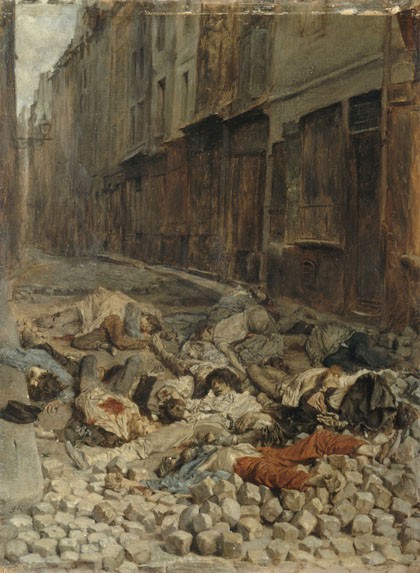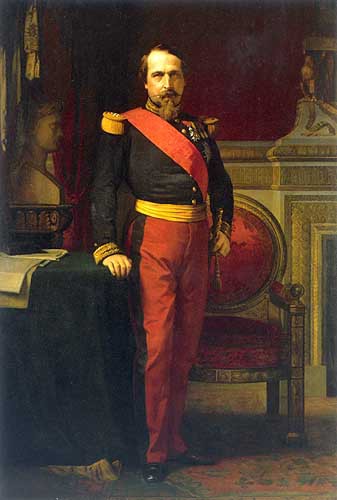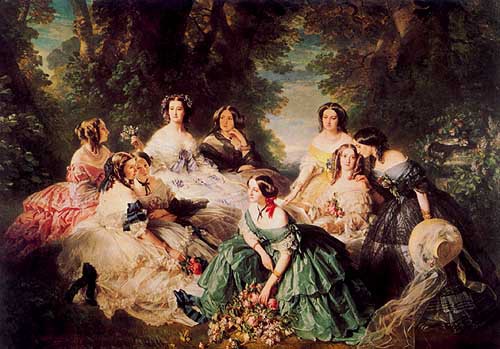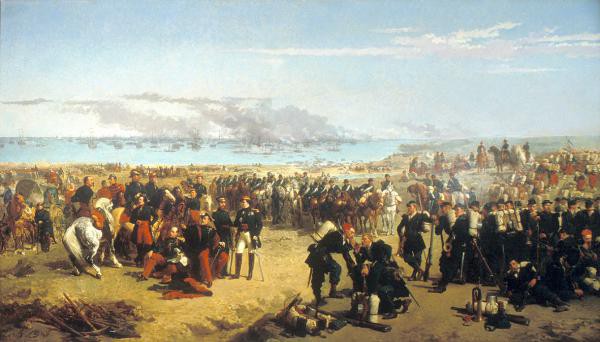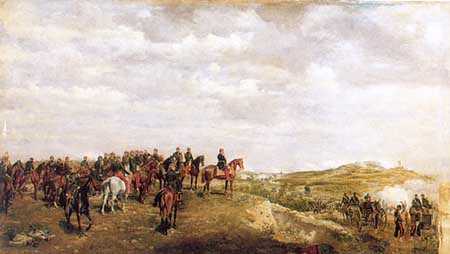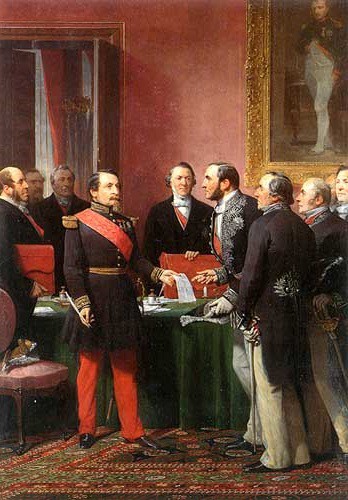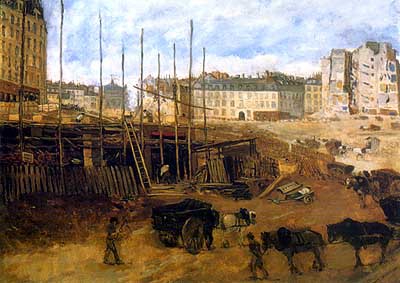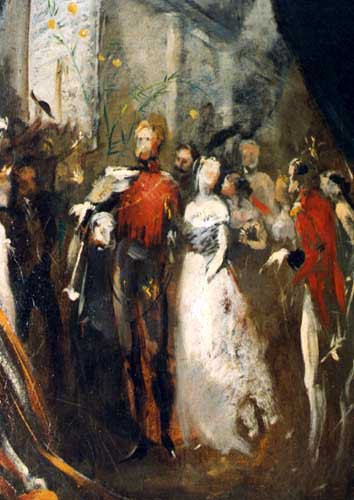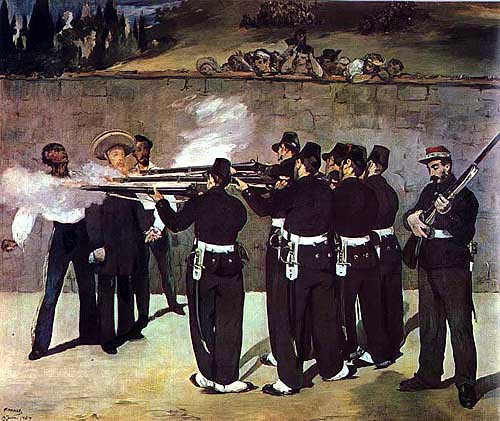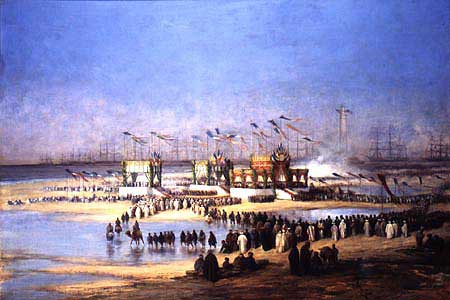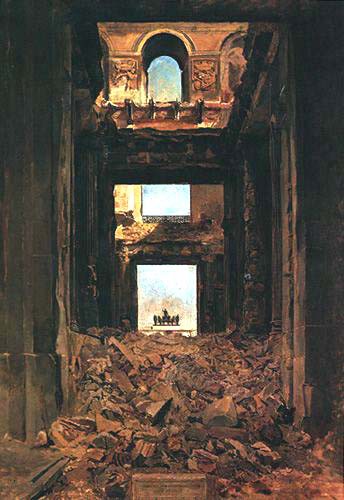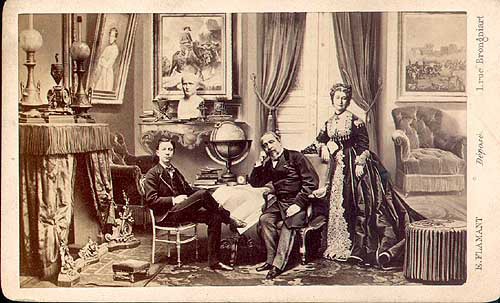-
The Second Republic
Artist(s) : MEISSONIER ErnestThe barricade, Rue de la Mortellerie, June 1848 known as Souvenir of the civil war
Paris, Musée du LouvreEnrolled as a captain in the Artillerie de la Garde nationale, Meissonier viewed at close quarters the days of 1848 during which the troops of General Cavaignac annihilated the Parisians in revolt. This small picture is almost a piece of reportage; the implacable realism of a daguerreotype. «This is the horror of the truth», was Delacroix’s comment.
The many disappointments resulting from the revolution of 1848 and the Second Republic opened to the door to Louis-Napoléon Bonaparte, enabling him to play a role on the French political stage. And he managed to rally to his cause not only the bourgoisie worried by the revolutionary disorders, and the peasants hostile to the Republic, but also a part of the working classes which believed in his social programme. On 10 December, 1848, Louis-Napoleon was elected President of the Republic. However, Meissonier’s barricade is the prefiguring of future brutal repression, namely that which followed the coup d’etat of 2 December, 1851, staining right at the outset the future Imperial regime. -
Napoleon III, Emperor of the French
Artist(s) : FLANDRIN Jean-HippolyteStanding portrait of Napoleon III, wearing the uniform of a Général de Brigade, in his Grand Cabinet at the Tuileries Palace
Versailles, Musée National du ChâteauThe Prince-President became ‘Emperor of the French’ under the name Napoleon III. In 1853, he commissioned the specialist in religious painting, Hippolyte Flandrin, a pupil of Ingres’s, to paint his portrait. Flandrin’s painting is psychologically very acute and, despite its official character, it skilfully reveals Louis-Napoléon’s complex personality. The artist even managed to catch the emperor’s ‘distant and inscrutable’ look. «This is without doubt the first ‘true’ portrait we have of H.M.» declared Théophile Gautier. This ‘truth’ however did not please Napoleon III; indeed so much so that the commission was cancelled. The emperor preferred the standing portrait by Winterhalter, now destroyed, with its more distinguished nobility and flattering idealisation. Napoleon III ended up however accepting Flandrin’s painting. First presented at the London Universal Exhibition in 1862 and then later at the Salon of 1863, this portrait met with great public success.
-
The Empress Eugénie
Artist(s) : WINTERHALTER Franz-XaverThe Empress surrounded by her maids of honour
Compiègne, Musée du Second EmpirePortrait painter to the courts of Europe, Winterhalter became the official painter of the imperial couple. In this exceedingly famous painting, he took his inspiration from 18th-century bucolic scenes and set the sovereign and her attendants in a shady forest clearing. And yet despite the rustic background, the ladies are wearing their finest ball gowns, giving Winterhalter an excellent opportunity to show off his virtuosity in the representation of material. It is the silk, the tulle, the muslin, the taffeta, the lace and the ribbons which are the real subject of this picture/hymn to the glory of the crinoline. And yet, whilst the portraits are lacking in psychological depth, the work gives a good impression of the pomp of court life. Indeed, it was this ‘show’ which was seen for the first time during the Paris Exposition Universelle in 1855, the first major public appearance of the imperial regime and a significant step towards its international recognition. Exhibited in the Salon d’honneur, Winterhalter’s painting was discreetly (because of the censor) panned by the critics, but it received enormous public acclaim at the time and is still greatly loved today.
-
The Crimean War
Artist(s) : PILS IsidoreThe landing of allied troops in Crimea in 1854
Ajaccio, Musée FeschEncouraged by the government, the history painters of the Second Empire became the self-appointed chroniclers of the military campaigns. The Crimea, Italy, Algeria, Mexico were for them just subjects to be illustrated and their works, exhibited to the public at the Salons, are strongly documentary in character. At the Salon of 1857, one of the Salles d’Honneur was entirely dedicated to episodes from the Crimean war. But the subjects were not so much acts of heroism as the complexity of the logistics and the new fighting techniques. Here, Pils shows daily life in the army. With the fleet disembarking in the distance, the military leaders (including Prince Napoleon, son of Jerome) are put on a level with the rank and file soldiers.
-
The Emperor at Solferino
Artist(s) : MEISSONIER ErnestNapoleon III at the Battle of Solferino, 24 June, 1859
Compiègne, musée du Second EmpireAt the beginning of the Second Empire, Meissonier was known only for his Dutch pastiche genre scenes. When the emperor bought a painting from him in order to offer it to Queen Victoria in 1855, however, Meissonier’s career was made. He then became attached to the Imperial staff in Italy in 1859 and he followed all the operations surrounding Magenta and Solferino. It was at that point that he launched himself into history painting. This Napoleon III at Solferino is the fruit of a very painstaking approach. Known as «the genius of the infinitely small», Meissonier also spent a great deal of time preparing for his pictures. He went back to the battlefield after the battle and spent a year doing portraits of the soldiers in the imperial escort. It was not until the Salon of 1864 that he finally exhibited the work. It is of almost photographic accuracy and it appears to ignore the battle completely, concentrating on the emperor who is watching the combat «like a chess player coolly studying the board».
-
Napoleon III and Haussmann
Artist(s) : YVON Henry Frédéric AdolpheNapoleon III hands to Baron Haussmann the decree annexing the Parisian suburban communes
Paris, Musée CarnavaletIn Paris, Napoleon III had an ambitious policy of urban regeneration. And he brought this policy to fruition through the talents of Baron Haussmann, Préfet of the Seine. On 1 January,1860, 11 communes were annexed: Auteuil, Passy, Les Batignolles, Montmartre, La Chapelle, La Villette, Belleville, Charonne, Bercy, Vaugirard and Grenelle. The French capital thus leapt from 12 to 20 arrondissements and from 3,288 to 7,088 hectares.
Commissioned by the Conseil Municipal in commemoration of the event, this painting was not liked and was refused because of its lack of grandeur. Yvon painted a second work which showed the imperial couple, the Préfet and the Conseil Municipal wearing their court robes. Since that latter work went up in flames with the Tuileries Palace in 1871, today the only version of the event is the one that was refused. -
The major construction work
Artist(s) : NITTIS Giuseppe deThe excavation of the Avenue de l’Opéra
Paris, Musée CarnavaletThe transformations made by Haussmann completely remodelled the capital. Second Empire society was witness to the disappearance of old Paris in favour of a healthy, aerated city, with large arterial roads giving excellent views of the recently built monuments, as can be seen here (the silhouette of the Opéra can be seen to the left, in the distance). This painting, which dates from 1878, clearly illustrates the extent of the construction work still going on even after the fall of the empire. Whilst the decision to build Garnier’s architectural masterpiece was taken in 1860, the façade was not officially inaugurated until 15 August, 1867, and the whole of the building complex was not totally finished until 1875, after the fall of the empire. In the same way, the digging of the Avenue de l’Opéra (then called the Avenue Napoléon and begun in 1864), was not to be finished until 15 years later.
-
The "Fête impériale"
Artist(s) : CARPEAUX Jean-BaptisteBall at the Tuileries
Compiègne, Musée du Second Empire
The Expositions Universelles of 1855 and of 1867 greatly contributed to the spread of the image of the splendour and pomp of imperial France. In 1867, all of the sovereigns of continental Europe came together in Paris, Alexander II, Franz-Josef, Ludwig II of Bavaria, Kaiser Wilhelm I of Prussia… Although Carpeaux is best known as a sculptor (he had carved busts of many of these rulers), he was also a painter who took astonishing liberties, and he made a series of paintings representing the fêtes and balls given on that occasion. His portraits reveal Carpeaux’s evident delight in the subject, as expressed through the rapid brush strokes and the heavy use of thick layers of paint.
Here the empress is making her entrance on the arm of the tsar. The moment thus seized is vibrant with colour and totally expressive of the atmosphere of the ‘Fête impériale’. And the perceived incompleteness of the painting and the refusal to identify either the subjects or the place simply serve to heighten the feeling of a fleeting, dreamlike vision. -
The execution of Maximilian
Artist(s) : MANET EdouardThe execution of Maximilian
Manheim, Stadtisch KunsthalleAt the same time as the huge Parisian triumph of the Exposition Universelle of 1867, international news arrived, casting a terrible pall over the fête. It was on 1 July, the very day on which the imperial couple were to distribute the prizes, that Paris learned of the execution of Maximilian, the puppet emperor set on the Mexican throne by Napoleon III. Like many of his contemporaries, Manet was greatly struck by the event. Indeed, in what was a rare foray into the historical genre, he chose a subject related to current affairs which had been largely avoided by other artists because of the censor. Taking his inspiration from Goya’s Tres de Mayo, a summary condemnation of another Napoleonic war, Manet chose the moment where the tension was at its highest: the firing squad execution of Maximilian and that of the two generals Mejia and Miramon. Greatly attached to this work, Manet never managed to exhibit it during the Second Empire, because the censor forbade it.
-
The inauguration of the Suez Canal
Artist(s) : RIOU EdouardThe inauguration of the Suez Canal
Compiègne, musée du Second Empire
In November 1869, the empress Eugénie journeyed to Egypt to preside over the inauguration ceremony of the Suez Canal. As cousin of Ferdinand de Lesseps, the builder of the canal, Eugénie had supported de Lesseps all along this gigantic project, speaking on his behalf to Napoleon III; indeed, de Lesseps was to call Eugénie ‘the canal’s guardian angel’.
In painting, orientalism was very much à la mode and, for once, current affairs followed suite. The ecumencial blessing ceremony took place at Port-Said. Three stands were erected set between the sky, the land and the sea. On the following day, the empress’s vessel led a flotilla down the canal. With hindsight, this was to be one of the last great prestige events of the Second Empire. -
The Fall of the Second Empire
Artist(s) : MEISSONIER ErnestThe ruins of the Tuileries
Compiègne, musée du Second EmpireThis painting eloquently sums up the historical events of 1870 and 1871: the fall of the Second Empire, the siege of Paris and the Commune. Passing in front of the burnt out shell of Tuileries Palace which had been set fire to during the «semaine sanglante», Meissonier was struck particularly by the state of the Salle des Maréchaux. There amongst the remains of the truncated gilt inscriptions he could pick out: «gleaming, intact, the names of the two clear victories …Marengo!…Austerlitz! ». A completely apocalyptic vision, the picture shows the destruction of the official residence of the kings and emperor of France. Looking through the gutted building, the viewer can see in the distance the chariot on top of the triumphal Arc du Carrousel. «It is Victory in her chariot leaving, abandoning us».
-
The exile of the imperial family
Artist(s) : FLAMANT E.La famille impériale à Chislehurst
Fondation Napoléon, collection Martial LapeyreThe rise of photography was so precipitous during the Second Empire that many saw in it a rival to painting. Certain genres, such as the portrait, were indeed seriously threatened by this new medium. And whilst the imperial couple continued to commission official portraits from painters, from the birth of the Prince Impérial in 1856 on they posed regularly for photographers. Reproduced and propagated widely, these photographs in which the sovereigns often appeared in scenes from their private life were very efficient official propaganda.
After the fall of the empire, the members of the imperial family in exile in England continued to «have their portraits taken ». This famous photomontage created from three separate photographs shows them in an interior decorated with Napoleonic memorabilia.K.H.
Credits: RMN, CGFA, The Artchive, Fondation Napoléon.
- The Second Republic
- Napoleon III, Emperor of the French
- The Empress Eugénie
- The Crimean War
- The Emperor at Solferino
- Napoleon III and Haussmann
- The major construction work
- The "Fête impériale"
- The execution of Maximilian
- The inauguration of the Suez Canal
- The Fall of the Second Empire
- The exile of the imperial family


